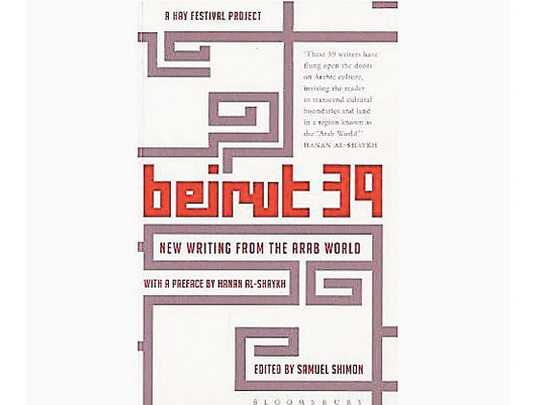
The Arab world is undergoing seismic transformations, groping its way towards new, as yet unknown forms, throwing up works of art and bombs in the process. In the face of vast complexity, however, and in a time of war, the media's first response is to dumb down.
If the news media simplifies, literature, by offering social and psychological context, broadens and diversifies our understanding of the region and particularly literature written by Arabs. The reading public seems to know this. Recent years have seen an increasing demand for Arabic writing in English translation, though continental Europe still translates far more.
So the publication of Beirut 39 — 39 pieces by Arab writers under 40 — is timely and worthwhile. The 39 writers are winners of a contest organised by Banipal magazine and the Hay festival. The book contains short stories, poems and extracts from novels.
Many of these worlds are alien to many readers, at least superficially. Libyan writer Najwa Binshatwan's The Pools and the Piano, for instance, opens: "We took time off our classes to clean the school of the black ashes left behind from the burning of the foreign-language books."
Abdullah Thabit imagines the harsh education of The Twentieth [9/11] Terrorist. In Ala Hlehel's ironic story, a Palestinian-Israeli writes to a resistance leader requesting that he send bombers anywhere but Haifa because after each attack in Haifa the writer is bothered by journalists working on "coexistence" pieces. But many pieces, even if their setting is unfamiliar, take us via individual lives into universal territory.
A justified grouping
Grouping work from such a vast geographical area is justified because the Arabs — whatever their spoken dialect or state loyalty — share a literary culture and a key range of religious, political and historical references. But Abdo Wazen's introduction, which argues that the new generation of writers destroys regional boundaries to create a pan-Arab literature — as there is now a "globalised" Arab cinema, music and news media — is debatable.
The stories and poems in Beirut 39, while open to pan-Arab and international influences, are textured according to their regional origins and their specific locations. They represent an unforced Arabism, no longer self-consciously "committed" and hence more suggestive, more profound in its implications.
The Egyptian stories are more urban, more densely social. Youssef Rakha's Suicide 20, or the Hakimi Maqama, which plays with Druze theology in contemporary Cairo and London, is the most intriguing of these.
Some tales originate in the state of ghorba (residence beyond the Arab world). Abdul Kader Benali's The Trip to the Slaughterhouse is a tale about a Dutch-Moroccan teenager. Randa Jarrar, who writes in English, addresses the problems of the old country. The Story of My Building retells Isaac Babel's Story of my Dovecoat, with the pogrom transferred to Gaza.
More alienated still than ghorba is the Iraq depicted in the extract from Ahmad Saadawi's Frankenstein in Baghdad, where a scrap vendor assembles body parts he finds littering the bomb-ruined streets to construct a composite corpse — which moves off of its own accord. Saadawi's hyper-realism reminded me of Hassan Blasim, who isn't represented here, despite being under 40 and perhaps the best writer of Arabic fiction alive. It would certainly be a mistake to believe that Beirut 39 is necessarily representative of the Arabs' best.
Beirut 39 is a rich and varied feast, but some of the extracts were too brief. The book offers a disconnected and slightly frustrating reading experience but it motivates you to search out the writers' full-length works. It is hoped the book will motivate publishers to publish more Arab writing and all of us to understand a little more.
Robin Yassin-Kassab's The Road from Damascus is published by Penguin.








